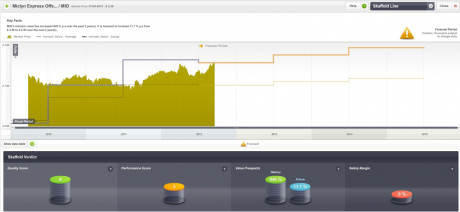Buoyant prospects in energy
PORTFOLIO POINT: Increasing demand for specialist offshore vessels from the oil and gas sector could result in an upwards revision of the earnings forecasts for maritime group Miclyn Express.
With the iron ore price falling rapidly in recent months, it almost seems as if the long-running commodities boom has been rushed to hospital suffering chest pains, and has been attended to by a variety of doctors offering a variety of opinions.
While some have offered a bright prognosis, others have checked their watch to determine the precise time of death.
My view is that the outlook for commodities depends on just which commodities you are looking at, and their particular supply and demand dynamics.
For example, I have, as you know well, held a cautious view on iron ore for almost a year, noting the apparent over-investment in supply and reliance on Chinese demand. However, I have a more positive outlook in other areas.
One area where I feel that the supply and demand outlook is more favourable is in energy, and I have turned my mind to which companies might benefit from this. One such company is Miclyn Express Offshore Limited (ASX:MIO).
MIO provides vessels to the offshore oil and gas industry, including support vessels, crew/utility vessels, and tugs and barges. MIO operates primarily in South-East Asia and Australia, and with a growing presence in the Middle East.
During the GFC the oil price fell dramatically from a peak of US$147 a barrel in 2008, to below US$70 a barrel in early 2009. In the wake of this decline, investment in offshore oil drilling fell away sharply, to the detriment of companies reliant on this industry.
More recently, the oil price has recovered to trade at around US$100 a barrel, and investment in offshore drilling in MIO’s core South-East Asian markets has been healthy. In addition, the Australian LNG market has seen robust levels of activity.
With the benefit of these tailwinds, MIO reported a record profit of $65.5 million for 2012, a healthy increase of 20% over 2011.
A key driver of profitability for MIO is the level of utilisation of its fleet of vessels, and in this regard, the foreseeable future looks bright, due to an apparent mismatch between the likely level of demand and the available capacity in the global offshore vessel fleet (OSVs).
Global OSV utilisation increased from 65% in 2010 to 76% in 2012, and is expected to reach 85% in 2013. Part of the issue is the age of the global OSV fleet, of which around 28% is older than 25 years and approaching retirement.
While new capacity is being added, this is expected to amount to only around 15% of the global fleet over the next few years. At a time when offshore exploration and production expenditure and demand for OSVs is increasing, the supply of vessels appears to be lagging, with insufficient investment in new capacity. This situation is the reverse of what we have dissected previously in the iron ore sector.
MIO appears well-placed to capitalise on this dynamic. Following significant investment in recent years (and with the benefit of its own Indonesian-based shipbuilding facility) MIO has a modern, efficient fleet and a good operational track record, making it a provider of choice for major clients.
In comparison with the industry’s average utilisation of 76%, MIO’s OSV fleet achieved 82% utilisation in 2012, with indications that this has further improved in the early part of FY13. As utilisation rates increase, I expect that so too will margins and profitability.
MIO currently rates as an A3 on Skaffold, indicating high quality, but only “average” financial performance, and its estimated intrinsic value is close to the current share price.
In addition, analysts are forecasting only modest growth in EPS for 2013, indicating slow growth in intrinsic value.
However, if my assessment of supply and demand dynamics is correct, earnings forecasts may need to be revised upwards as the year progresses. This will flow through to a more favourable view on valuation, and potentially an improved performance score for FY2013.
Looking further ahead, MIO may not be a business I am comfortable with for the very long term:
Supply and demand dynamics appear to be good for now, but operational leverage works both ways, and there may be times when industry overcapacity makes it difficult for MIO to earn an attractive return on its fixed asset base.
I will hold shares in MIO with the same open hand I did the mining services businesses – I sold those in April this year.
As FY13 progresses however, MIO looks like it may have the wind firmly at its back.
Roger Montgomery is an analyst at Montgomery Investment Management and author of Value.able, available exclusively at rogermontgomery.com.

















